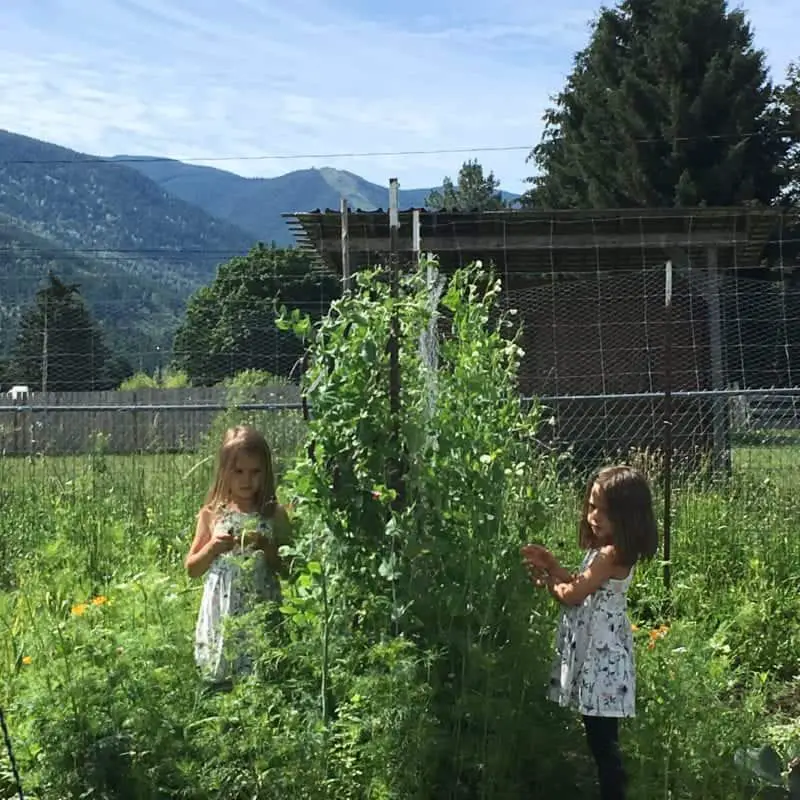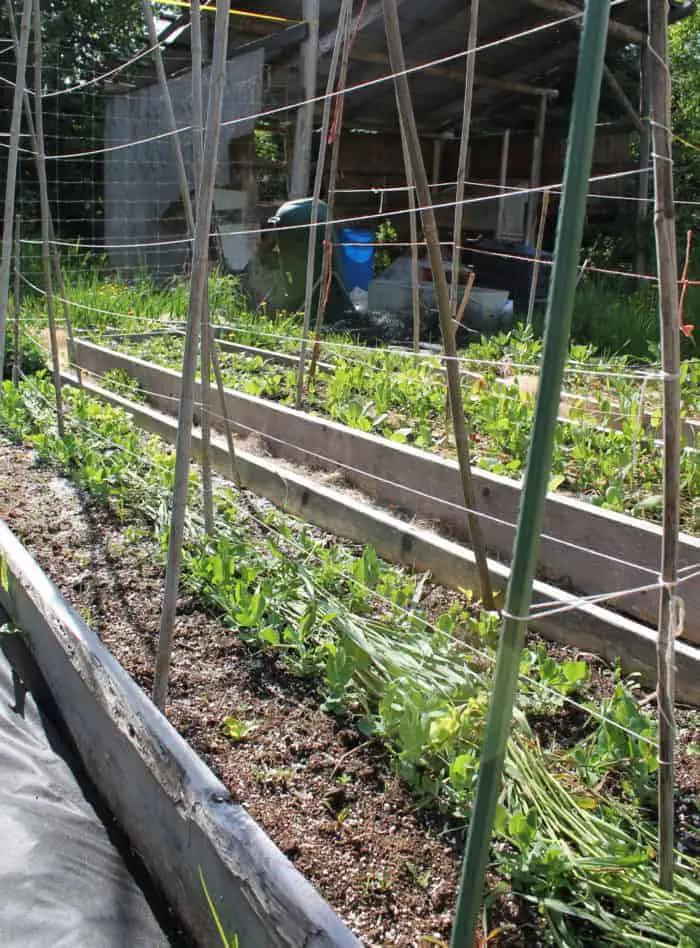Sugar snap peas, shell peas, and snow peas are the three main types of peas you can grow.
They are all related, but also have their differences especially when it comes to harvesting. Growing peas is easy and they’re a fun crop to grow.
Pea Plants
These are the most common pea plants that gardeners grow:
- Shelling pea/English pea/common pea- This is the pea that many people picture, little round green peas. These are harvested when the pods are plump and can be saved later on for soup peas.
- Snow peas- these are the large stir fry peas picked before any peas inside form.
- Sugar snap peas- these peas have little round green peas inside that you eat but the shell is also edible. This means this variety is great if you get hot springs because you can harvest at more than one stage. The full pod is edible like snow peas, but these are harvested just a little more plump.
I suggest separating the varieties or labeling them carefully, as some of the pods can be eaten. For example if you’re growing sugar snap peas and shelling peas you’ll want to know which is which. If you grow them all together in a row, you might forget which ones you can harvest and eat the pods of (although after a bite you’ll likely know as shelling pea pods are super chewy).
Did you know you can get purple hull peas?


Some pea plants are bush peas that don’t need a trellis, however most peas do.
When choosing your pea seeds not only is variety important and type make sure you pay attention to whether or not they are bush or need a trellis.
Most pea varieties need a trellis, and I’ll discuss mistakes to avoid when building a pea trellis soon.

Growing Peas
Peas belong to the family Fabaceae and are great for many reasons: peas are easy to grow, they are nitrogen fixing plants and are a great space saving crop.
Peas are a cool season crop and can be sown in both spring and fall, depending on where you live. Sow in the spring from Feb-May as soon as the soil can be worked and again in July- August for fall harvesting. I often prefer the bush varieties like Sugar Ann in the fall as sometimes the fall weather is unpredictable and there’s not enough time to set up a trellis.
You can directly sow peas outside or start them indoors and carefully transplant them after they are 2 weeks old

Growing peas is rewarding & the more your pick, the more you get!
Peas are one of the crops you can directly sow outside before your last spring frost. Although it’s not as common, you can also grow pea plants inside and transplant them outside. This requires extra care because peas don’t like root disturbance. I’ve grown pea plants inside and transplanted them under hoop tunnels for an extra early head start. Although it was a lot of work, we did get peas 3 weeks sooner because peas sometimes won’t germinate in cold wet soil.
If squirrels or birds are a common garden pest they’ll sometimes steal pea shoots so growing pea plants inside and transplanting sometimes works better.
I succession plant peas, doing an early crop under a hoop tunnel (as you can see in the photo below) and then another round closer to the last spring frost.

Peas like well drained soil and some compost, although I’ve had them grow in poorer soils.
Some people use a seed inoculant to increase potential beneficial bacteria. Sow seed 2cm (1″) deep and space seeds about 2-7cm (1-3″) apart in the row. You can get away with closer spacing because not all peas will sprout.

Growing Peas Trellis
It’s better to set up your pea trellis when you plant your seeds rather than when they are too tall because you might damage pea plants.
Peas that need climbing will require a tall and sturdy trellis. Some peas can reach 10-12 feet! Your seed packet should say how tall they get, because some like tall telephone get taller than others.
Unlike beans, peas don’t just grow upwards, they have side tendrils that like to attach to something.
If peas don’t have anything to attach to something they will attach to each other making them more vulnerable to falling in the wind. This means that when you set up your trellis, strong cross strings or fencing is preferred over just poles.
Below you can see metal posts with hardwire offer a double sided pea trellis for increased growing area

You don’t want your trellis supports to be too narrow, they need a wide stance for better support.
Below you can see bamboo poles and cross strings were not strong enough of a support.

Later in the season this trellis collapsed from the weight and lack of support

Below is a good strong pea trellis made from fencing and metal posts deep in the ground

What is your fav pea to grow? Ours is growing sugar snap peas 🙂










What can one do with the snow pea after the peas have grown inside the pod?
…..oops!
I think you can still eat them, they tend to be tougher though towards the end of the season. I’ve sauteed them in the pod if they’re small 🙂